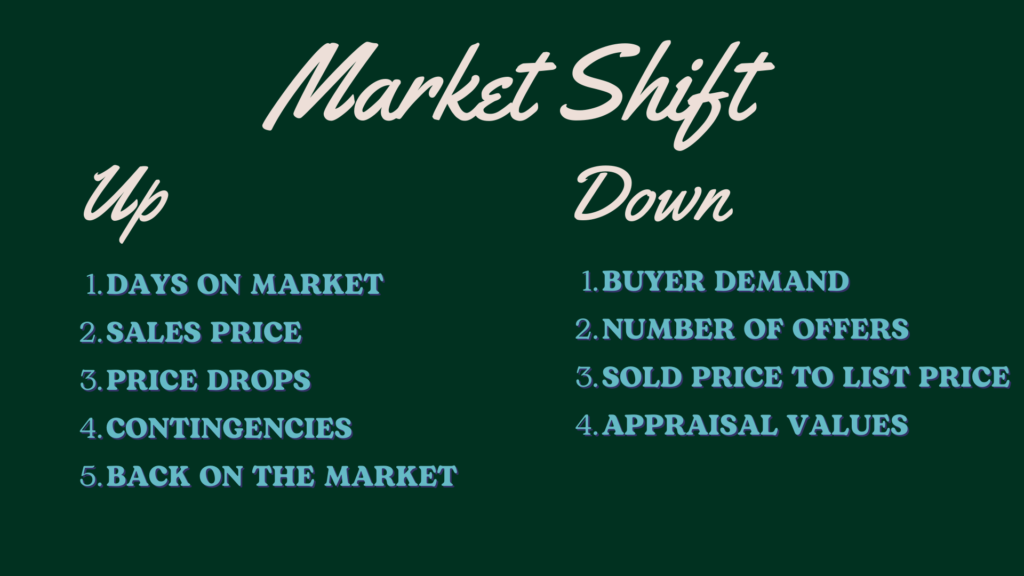9 INDICATORS OF A MARKET SHIFT
In hindsight, the market has shifted. As recession looms and mortgage interest rates spiked, many home buyers were no longer eager to find a home and many decided to give up all together. Still, homeownership is the dream of many who are frustrated with paying rent or need to move to an area for work. And life events make it mandatory that others pub their homes on the market. So what is this real estate market shift? Here are 9 areas that help to explain what is happening.
1. BUYER DEMAND
Buyer demand has gone down. There are now less people looking for homes to buy. Real Estate Agents, like myself, are seeing less showings on homes for sale and less people attending open houses. Even Bright MLS has reported a decreased demand in the DC metropolitan area since last year.
2. DAYS ON MARKET
Days on Market for homes for sale has gone up. This means that it now takes longer for a Seller to receive an offer, negotiate, and agree to terms with a Buyer. While many homes for sale would “fly off the shelf” a few months ago, it’s not uncommon to see homes still in Active status two weeks later.
3. NUMBER OF OFFERS
Affecting the Days on Market indicator is the number of offers. Many agents are reporting that they are receiving less offers on the homes they have for sale than in the past. This makes Sellers more likely to accept their first reasonable offer. The likelihood of a qualified buyers getting the home they want is now better.

4. PRICE DROPS
There are more homes dropping the price of the home after it hits the market. For example, a home may be listed originally at $500,000 and after 2 weeks has not received an offer or had many showings. The Seller may then decide to drop the price by $20,000 to allure more qualified buyers and hopefully negotiate a contract. This is happening more and more as the market shifted.
5. MORE CONTINGENCIES
Once homes go under contract, there are more contingencies tied to the sale. In the strong Seller’s market, many contingencies like home inspection and appraisals were being waived by Buyers to be competitive and get their offer accepted by a Seller reviewing multiple offers. For the most part, this is happening less and less. Home inspections are back and Buyers and Sellers are negotiating repairs. Buyers are also no longer willing to take on the added cost if a home does not appraise to the loan amount. It means that if a home does not appraise up to the sale price, there is an option to negotiate.
6. SOLD PRICE VS. ORGINIAL LIST PRICE
The ratio of the amount a home sells for and the amount that was asked is decreasing. In the height of the Seller’s market, the sold price was on average 105% higher than the original asking price. Still, homes are being sold for a higher amount than the asking price but this percentage has fallen to about 101%. According to InsideNOVA, “Sellers in the five largest Northern Virginia localities, received, on average, more than original listing price for homes that went to closing in June, according to new data”.

7. APPRAISAL VALUES
Something that Sellers and Buyers should be aware of is that some appraisers are using more recent sales to determine market conditions. This is usual when market conditions are changing rapidly as they did in 2020 during the pandemic. Now, again, the market is shifting back to more normal conditions so more recent sales may show homes having less value than during the height of the Seller’s market.
8. BACK ON THE MARKET
More homes are “back on the market” after going under contract. There are many reasons for this. As interest rates rose, some Buyers qualification changed may have changed and they were no longer able to pay a higher monthly mortgage. Without financing, contracts may have to be voided. With contingencies like home inspection and appraisals back on the table, there are also more opportunities for there to be disagreement and a contract falling apart.
9. SALES PRICE
According to the Northern Virginia Association of Realtors (NVAR), the Sales Price of homes in Northern Virginia continue to increase despite buyer demand and market conditions changing. While home values were increasing as much as 20% in 2020, the price is now at a more normal 5% growth rate.
WATCH THE RELATED VIDEO …
Bottom Line
Northern Virginia is still a great place to buy or own a home. The value of homes consistently go up each year despite market conditions.
Questions/Concerns? Please contact me.
Also feel free to compare this update with last month’s Market Update – July 2022

